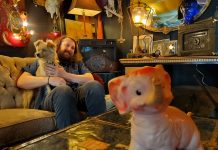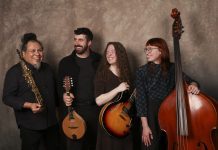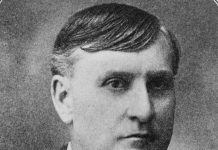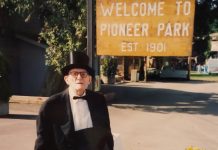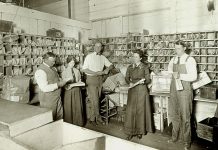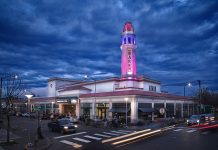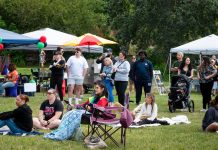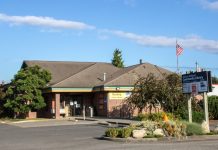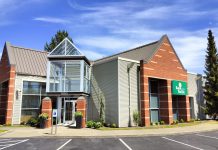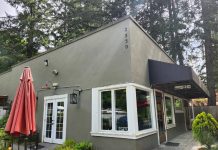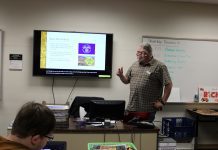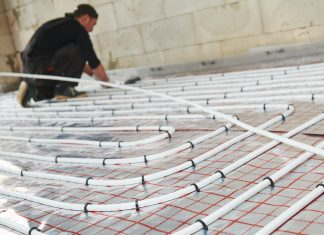Like wet newspaper, another old wasp comb clings to a swallow box roof. “Aww, darn. This is why the boxes must be checked,” says Veronica, scooping out the mess and replacing it with a layer of fresh wood shavings. In a successful nest, the swallows will thatch this faux wood rot with dried grasses, then line it with feathers gleaned from molting larger birds. But for now, Tricia kills off the few winter-weary insects on the front board, raises it and with a quick – bzzzzz – Veronica drills it back in place. “Two more to go,” she says, climbing down the ladder.
 The six boxes at Sisters Christmas Tree Farm near Van Zandt are among 120 swallow boxes that Veronica Wisniewski and Tricia Otto have installed in fields and meadows throughout Whatcom County. In agricultural areas with rough pasture (and perhaps a good barn), they have 51 barn owl boxes. And along forested ponds and streams? 120 wood duck boxes. Each species has a unique cavity and hole fit to its body. And though unwanted nest-fellows may slip in, most all are proofed against intruding raccoons and raptors.
The six boxes at Sisters Christmas Tree Farm near Van Zandt are among 120 swallow boxes that Veronica Wisniewski and Tricia Otto have installed in fields and meadows throughout Whatcom County. In agricultural areas with rough pasture (and perhaps a good barn), they have 51 barn owl boxes. And along forested ponds and streams? 120 wood duck boxes. Each species has a unique cavity and hole fit to its body. And though unwanted nest-fellows may slip in, most all are proofed against intruding raccoons and raptors.
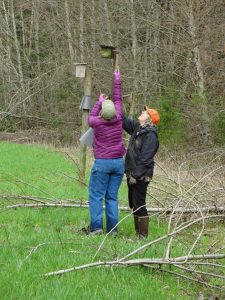
Birds haven’t always lived in boxes. Historically, the wounds of dead, standing trees made life possible for these cavity-dependent nesters. But in 1988, when Tricia moved to a cutover property along a creek that flows into Lake Whatcom, she found few of these “snags” for birds to use. So she gave nest boxes a try, in all style and circumstance: little ones (for chickadees), medium ones (for flickers) and big ones (for ducks); in the woods, near the water, out in the open. After five years, the real estate trends were clear: without good snags in the forest, the ducks were desperate. “The more boxes I put up,” Tricia recalls, “the more were occupied.”
Anyone who loves birds, or knows Tricia, will understand why this was no small temptation. As Tricia’s energy mounted to extend the project beyond her property, she met Veronica, who was then working with the Nooksack Salmon Enhancement Association (NSEA).
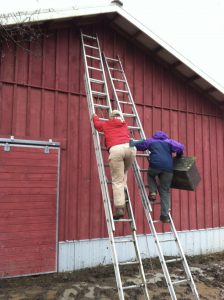
Photo Credit: Tricia Otto
Veronica had also started to experiment with wood duck boxes, along the creeks that NSEA helped restore. Initially, Tricia challenged Veronica’s placement among NSEA’s newly planted trees, thinking her boxes should be deeper in the woods where starlings wouldn’t pirate them. But soon enough they reached an agreement and, today, they have extended the project with 82 collaborating landowners countywide.
Even if the big, holey trees were lacking, their stumps remained useful. Purchasable boards proved insufficient for duck and owl boxes – which require at least a 12″x12″ base – so Tricia and Veronica enlisted Jack Sturgeon, Wally Clark and George Garlick to salvage what they could from the hefty stumps that logging crews left behind. They found durable success with cedars, and using Wally’s sawmill and their collective tinker-power, they improved the duck box designs of the legendary waterfowl conservationist Frank Bellrose. Instead of an awkward reach from above, their boxes would open from the side, an accommodation that greatly enhanced safety and access from their simple orchard ladders.
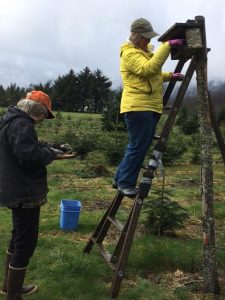
With duct-taped foam padding worn from frequent shoulder carries, their ladders have gotten a lot of mileage. They visit every box at least once per year, transported back and forth and back on Tricia’s 1987 Volvo, whose trunk is stuffed with drills, hammers, a posthole digger, a shovel and a whole lot of screws. One day a week, Tricia and Veronica make rounds to maintain boxes for their landowners, most of whom they’ve met through word of mouth. Scott Delbecq worked with them in the early years too – when he grew from age 12 to 20 – providing the crucial teenage muscle that heaved most of the original boxes into place. In 2006, this trio won Re-Sources’ Environmental Heroes Award for their efforts, which by then had already nurtured thousands of birds that Whatcom County might never have known.
And over a decade later, their work goes on, with many more birds on the wing. Scott is now a doctoral student at UW, but Tricia and Veronica still follow nesting seasons like fishermen do tides. Duties ramp up in late summer, when the great cycle of cleanouts begins with the wood ducks, then by early fall, the barn owls. This intensive housekeeping deters invaders and prevents next year’s nesters from laying in last year’s failures. But it also extends the meticulous tally that Tricia and Veronica keep on each box’s history. With this information, they might add or move boxes to better locations through winter. By early spring, they’re racing to clean and erect any storm-fallen swallow boxes before their early-migrating tenants return from Central America.
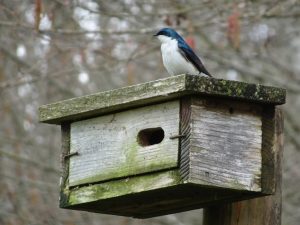
Changes in climate and land use practices are making this trek more challenging each year. Even for our non-migratory wood ducks, loss of wetland habitat remains an obstacle that goes beyond what boxes can do. But the barn owl program is growing, which should be great news for local farmers, given how these birds offer some of the most organic, effective rodent control around.
As Veronica and Tricia closed out their day in late March, more good news arrived, just in time: three male tree swallows swooping down, announcing themselves with twitters and scolds. After a few tumbles and taunts, one landed on the last, just-cleaned box to stake his claim. It was a successful one last year and it seemed to hold promise for this year, too.

